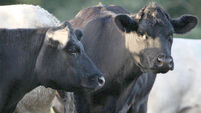Co-op boards urged to raise their milk prices
He said the Irish milk price was well behind market developments, and pointed out that in 2011, when the Irish Dairy Board price index was at its current level, dairy farmers here were paid 34 cent per litre in most co-ops.
Global dairy prices started 2013 on a firm note in the Global Dairy Trade auction, rising to their highest in nearly a year. The 20% increase since mid-December included a 4.7% price increase for skim milk powder, to a 19-month high. Prices rose 1.9% for cheddar, and 1.6% for whole milk powder, which makes up the vast majority of volumes on offer.
The giant New Zealand milk processor Fonterra runs the auction and provides most of the product sold through it — and the price rises reflect doubts that New Zealand can maintain its strong milk output start to 2012-13, with drought conditions threatening, and New Zealand grass growth potential below normal for much of December.
The slow recovery in international dairy prices that began in August continued into the final quarter of this year, but failed to gain momentum, according to Rabobank’s latest dairy market report.
According to the global leader in food and agri banking, consumption remained weaker than anticipated and key buyers had secured forward supplies.
Rabobank expected milk production growth in key export regions to continue to fall in the first half of 2013 and the global market to tighten further if there was even a modest improvement in demand for imports from key buying regions.
There was reduced production in all of the main European dairying states in the second half of 2012, and Rabobank expects EU milk production to more or less track 2012 levels through the first half of 2013.
During the cold and wet summer in Western Europe, cows needed supplementary feeding and, in some cases, shelter. Farm input prices also rose as feed markets reacted to the news of the US drought. Higher fertiliser and energy costs further exacerbated the troubles of farmers.
Milk supply growth in the US is expected to fall behind 2012 levels in the first half of 2013.
Mr McCormack said he was optimistic that farmers can look forward to a strong milk price in 2013 — which he said they need, to cope with ever-escalating input costs.










